1

Anti-ClpC | Chloroplastic form of HSP100
AS01 001 | Clonality: Polyclonal | Host: Rabbit | Reactivity: A.thaliana, C.reinhardtii, cyanobacteria, Plectonema sp., Streptomyces sp.
- Product Info
-
Immunogen: Recombinant ClpC (C-terminal domain overexpressed as fusion with maltose-binding protein), UniProt: Q55023
Host: Rabbit Clonality: Polyclonal Purity: Serum Format: Lyophilized Quantity: 100 µl Reconstitution: For reconstitution add 100 µl of sterile water Storage: Store lyophilized/reconstituted at -20°C; once reconstituted make aliquots to avoid repeated freeze-thaw cycles. Please remember to spin the tubes briefly prior to opening them to avoid any losses that might occur from material adhering to the cap or sides of the tube. Tested applications: Immunoprecipitation (IP), Immunohistochemistry (IHC), Western blot (WB) Recommended dilution: 1 : 1000 (IHC), 1 : 5000 on 10 µg of total protein, (WB) Expected | apparent MW: 92 | 87 kDa
- Reactivity
-
Confirmed reactivity: Arabidopsis thaliana, Synechococcus sp., Chlamydomonas reinhardtii, Streptomyces sp. Predicted reactivity: Algae (red), Catalpa bungei, Hordeum vulgare, Nicotiana tabacum, Ostreococcus sp., Oryza sativa, Populus trichocarpa, Physcomitrium patens, Pisum sativum, Solanum tuberosum, Zea mays
Species of your interest not listed? Contact usNot reactive in: Different strains of Mycobacterium smegmatis - Additional Information
-
Additional information: Anti-ClpC antibodies will also recognized Arabidopsis thaliana isoform ClpC1 (At5g50920) and ClpC2 (At3g48870).
- Background
-
Background: ClpC is a chloroplastic protein of the Hsp100 family. It is believed to function as a housekeeping enzyme, both in its capacity as an independent molecular chaperone and as the regulatory component of the Clp protease.
- Product Citations
-
Selected references: Mu et al. (2024). Plastid HSP90C C-terminal extension region plays a regulatory role in chaperone activity and client binding.Plant J. 2024 Jul 5.doi: 10.1111/tpj.16917.
Jiang et al. (2020). Plastid chaperone HSP90C guides precursor proteins to the SEC translocase for thylakoid transport. J Exp Bot. 2020 Aug 27;eraa399.doi: 10.1093/jxb/eraa399.
Lee et al. (2018). Prolines in Transit Peptides Are Crucial for Efficient Preprotein Translocation into Chloroplasts. Plant Physiol. 2018 Jan;176(1):663-677. doi: 10.1104/pp.17.01553. Epub 2017 Nov 20.
Hu et al. (2015). Site-specific Nitrosoproteomic Identification of Endogenously S-Nitrosylated Proteins in Arabidopsis. Plant Physiol. 2015 Feb 19. pii: pp.00026.2015.
Rosano et al. (2011). Insights into the Clp/HSP100 chaperone system from chloroplasts of Arabidopsis thaliana. J Biol Chem. Aug 26;286(34):29671-80. (Western blot, Arabidopsis thaliana)
Karradt et al. (2008) NblA, a Key Protein of Phycobilisome Degradation, Interacts with ClpC, a HSP100 Chaperone Partner of a Cyanobacterial Clp Protease. J Biol Chem 283: 32394-32403. - Protocols
-
Agrisera Western Blot protocol and video tutorials
- Reviews:
-
PO-TING CHAN | 2013-04-18This antibody AS01 001 is really good with its high specificity. I used it for immunoblotting with 1:2500 dilution by the AP-coloring method. In my practice, this antibody can even recognize ClpC well in 2.5 ?g chloroplasts of pea.Gorovits Rena Jerusalem University | 2008-11-16perfect antibody, works in different protein extractions in several plant species (tomato, tobacco), gives repeated results



